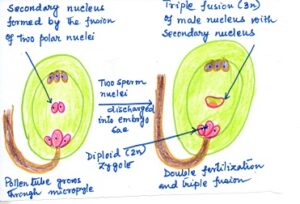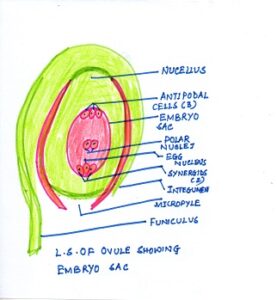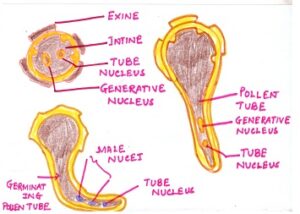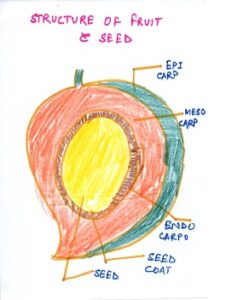FERTILIZATION IN PLANTS
Definition
Fusion between male gamete and female gamete of plant is called fertilization.
Events of fertilization
A] Pollination brings female and male gametophyte together- The male and female gametophytes must meet and unite their gametes to fertilize egg. This is done by pollination, in which pollen is placed on the stigma of the carpel.
B] Germination of pollen grain under suitable condition– The cytoplasm of the pollen grain absorbs sugar and water from the stigma and bulges out to produce a tube known as pollen tube by braking down exine of pollen grains. This germinating pollen tube grows down through the stigma and style of flower towards the micropyle of the ovary. This tube produces chemical, calcium such as that dissolves the tissues of the style and the tip of the pollen tube enters the ovary through the micropylar end occurring double fertilization.
Fig#1 simplified diagram of double fertilization of the flower
C] Division of Nucleus– The generative nucleus of the pollen grain divides by mitosis and forms two male gamete nuclei or sperm nuclei. The pollen grain, with tube containing two male gamates constitutes the mature male gametophyte. The ovule contains the egg cell inside the embryosac.
D] Entry of pollen tube– The tip of pollen tube after entering the ovary through the micropyle, ruptures and discharges two male gametes into the embryosac.
E] Double Fertilization- One of the male gametes fuses with the egg to form the zygote. This fusion is called fertilization. Another Male gametes fuses with the deploid secondary nucleus. This nucleus is formed by the fusion of two polar nuclei. Later forms the endosperm which is a food storing tissue. In this way double fertilization occurs
Diagrammatic representation of steps of fertilization
Anther
↓
Pollengrain
↓
Stigma
↓
Pollen tube
↓
Micropyle
↓
Embryo sac
↓
Fusion between male gamete + egg cell→ Zygote
↓
Male gamete+ secondary nucleus→ Endosperm
DOUBLE FERTILIZATION AND TRIPLE FUSION

Fig#2 diagram of double fertilization and triple fusion
As this process involves the fusion of two male gametes separately, One with the egg and the other with the secondary nucleus, this process of fertilization is called double fertilization.
Male gamete (1n) + Egg cell (1n) = Zygote (2n)
Male gamete (1n) + Secondary nucleus (2n)= Endosperm (3n)
1n = Haploid
2n = Diploid
3n = Triploid
The fusion of Second male gamete with already fused polar nuclei (Secondary nucleus) is called triple fusion because it involves the fusion of three nuclei and produces a triploid endosperm cell. (PLANT FERTILIZATION)
STRUCTURE OF OVULE

Fig#3 simplified diagram of ovule
Ovule is a small structure contained in the ovary: Each ovule is surrounded by two integuments. At the apex, ovule has a minute pore called micropyle. Each ovule contains an embryo sac. It is surrounded by a nutritive tissue called nucellus. The embryo sac consists of two polar nuclei which fuse to form secondary nucleus (Primary endosperm nucleus). The egg cell of female gamete lies towards the micropyle. The embryo sac also contains two synergid cells and three
antipodal cells.
POLLEN GRAIN

Fig#4 diagram of pollen grain
Pollen grain is a spherical or oval structure. It has two coverings: the outer thick exine and the inner thin intine. Exine is rough and spinous and bears minute pores called germ pores. The dense cytoplasm within the pollen grain has two nuclei: generative nucleus and the vegetative nucleus or tube nucleus.
FACTS ABOUT POLLINATION (PLANT FERTILIZATION)
Pollination takes place among the plants of same species. Many different kinds of flowering
plants like papaya, mango, guava, litchi may be growing along with trees like neem, jamun or sheesham. Similarly various crops like wheat mustard, pulses may be growing in neighboring
fields. The pollen blown off from these plants by the wind may be received by the stigma of a particular plant. Similarly, bees and butterflies collect nectar from all kinds of flowers and carry different kinds of pollens on their body. Thus the stigma of a flower of any particular plant receives pollen of its own species as well species of other plants. But, only the pollens from the plant of the same particular species are able to germinate to carry the process of fertilization and rest of them fail to germinate and perish.
CHANGES OCCURRING IN OVARY DURING FORMATION OF FRUIT
Ovary fruit.
Ovary wall Pericarp
Ovule Seed
Placenta Stalk of seed
Hilum Hilum
Nucellus Generally degenerates in some cases it persists as a thin layer called Perisperm
Integument
outer Testa
Inner Tegmen
Embryosac ,synergids and antipodal Cell Degenerate
Egg cell Embryo
Secondary nucleus Endosperm
SEEDS
Seed is the final outcome of sexual reproduction in flowering plants. It marks the beginning of a new generation.
A seed can be defined as a fertilized ovule that possesses an embryonic plant having plumule and radicle, stored food and protective coat.
SEED FORMATION
The zygote divides repeatedly to form the embryo. The embryo cosists of a root like radicle and a stem like plumule, and one or two leaf like cotyledons. The primary endosperm nucleus after repeated divisions forms the endosperm. The ovule becomes the seed and its two integuments form the two seed coats. Endosperm persists in endospermic seed only. In non-endospermic seeds, it is absorbed by the developing embryo and food is stored in the cotyledons.
SIGNIFICANCE OF SEED
*Seed is the beginning of new generation.
*Seed represents a miniature plant with adequate supply of reserve food to be used
at the time of germination.
*In this way seed is a means of perennation to tide over the unfavourable climatic conditions.
FRUIT
Fruit may be defined as a mature ripened ovary. It encloses seeds till they are ready to germinate.
FRUIT DEVELOPMENT (PLANT FERTILIZATION)

Fig#5 structure of fruit and seed
Following fertilization, the calyx, Corolla style stigma and stamens wither and fall off. The ovary ripens into a fruit. The wall of the ovary becomes the fruit wall, the pericarp.
The fruit contains one or many seeds. These remain attached to the ovary with the placenta. When the fruit ripes, the seeds are released and grow into new plants under suitable conditions.
SIGNIFICANCE OF FRUIT
* Fruit protects the immature seeds from unfavorable environmental conditions.
* Immature fruits protect seeds from any damage like animals because they have unpalatable or repelling chemicals.
*Mature fruit attracts animals by its flavour, taste and colour to assist in the dispersal of seeds.
* Some fruits dry up on maturity and burst with pressure to spread seeds to long distance.
In this way journey of ovule and pollen grains merge with the dispersal and germination of seed into new seedling.
————————————————————————————————————————————————-